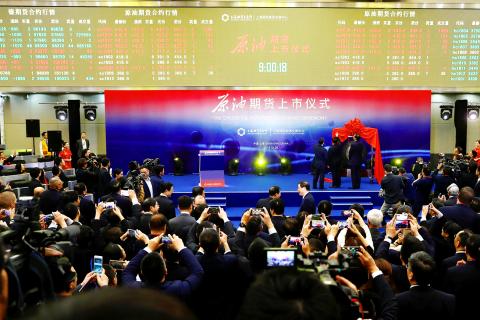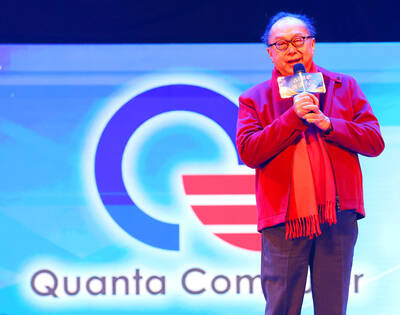China yesterday launched its first-ever crude oil futures contract as the world’s biggest oil buyer seeks to wield greater power over pricing and challenge the benchmarks in the US and Europe.
Long-awaited yuan-denominated futures on the Shanghai International Energy Exchange traded at 427.90 yuan a barrel (US$67.78) for September settlement at 2:13pm, with about 18,540 lots changing hands.
The contracts, which are open to foreign investors, end years of delays and setbacks since China’s first attempt to list crude oil futures in 1993.

Photo: Reuters
September contracts of the two major US dollar-based oil benchmarks, Brent in London and West Texas Intermediate in New York, traded near US$68.29 and US$64 a barrel respectively.
China’s desire to open a domestic market to trade futures has grown as the nation’s crude oil imports have boomed.
It last year surpassed the US as the world’s biggest buyer of foreign oil.
The contracts might not only help wrest some control over pricing from the main international benchmarks, but yuan-denominated contracts could also promote the use of its currency in global trade — a key long-term goal for Asia’s biggest economy.
“China has used this contract in an innovative way, to fill the void of a voice representing buyers in Asia,” Shanghai-based ICIS-China analyst Li Li said. “With this launch, the market will pay more attention to China’s demand story.”
Futures for September settlement opened at 440 yuan a barrel, up from a reference price of 416 yuan.
The exchange said that foreign companies, including Glencore PLC and Trafigura Group, participated in the debut via brokers.
Allowing foreign investors to trade the futures directly is a first for China’s commodity markets.
To attract more participation, China plans to waive income taxes for overseas individuals and institutions.
About 19 foreign brokers had registered to trade the contracts as of last week, the exchange said.
While the nation hopes to establish a benchmark for global oil transactions, whether the Asian nation would achieve that goal has been the subject of hot debate.
Skeptics argue that hurdles such as capital controls, regulatory risk and market intervention in other Chinese securities have made investors cynical about the prospect of Shanghai futures becoming a regional price-setter.
Similar obstacles have kept foreign investors as bit players in the nation’s giant stock and bond markets.
Meanwhile, crude futures that were tested in Singapore and Japan have since faded to obscurity due to low liquidity.
“It’s hard to see it becoming a major driver of oil prices in the short to medium term,” Australia & New Zealand Banking Group senior commodities strategist Daniel Hynes said. “I still think there is a general reluctance from global investors to trade Chinese-based contracts.”
While he is not particularly watching it closely for the moment, ANZ’s Chinese desk is very focused on it, he said.
Then there are the bulls, such as hedge fund manager Adam Levinson, who says the start of “petro-yuan” would be a “huge story” and increase the use of the Chinese currency in trade settlements.
For China’s regulators, the hope is that the futures would serve as a risk management tool for its oil companies, act as a price reference for industry participants, as well as help open the nation’s financial markets.
With one eye on success, the authorities are also wary of any potential bubbles created by the millions of wealthy retails investors living in the world’s second-largest economy.
Trading in futures, from apples to steel, has exploded across the nation’s three commodity exchanges, prompting regulators to repeatedly step in to quell fears of a bubble.
One way of tempering the froth has been to limit physical delivery space for barrels of oil as well as setting storage costs that are double the rate elsewhere.

Intel Corp chief executive officer Lip-Bu Tan (陳立武) is expected to meet with Taiwanese suppliers next month in conjunction with the opening of the Computex Taipei trade show, supply chain sources said on Monday. The visit, the first for Tan to Taiwan since assuming his new post last month, would be aimed at enhancing Intel’s ties with suppliers in Taiwan as he attempts to help turn around the struggling US chipmaker, the sources said. Tan is to hold a banquet to celebrate Intel’s 40-year presence in Taiwan before Computex opens on May 20 and invite dozens of Taiwanese suppliers to exchange views

Application-specific integrated circuit designer Faraday Technology Corp (智原) yesterday said that although revenue this quarter would decline 30 percent from last quarter, it retained its full-year forecast of revenue growth of 100 percent. The company attributed the quarterly drop to a slowdown in customers’ production of chips using Faraday’s advanced packaging technology. The company is still confident about its revenue growth this year, given its strong “design-win” — or the projects it won to help customers design their chips, Faraday president Steve Wang (王國雍) told an online earnings conference. “The design-win this year is better than we expected. We believe we will win

Quanta Computer Inc (廣達) chairman Barry Lam (林百里) is expected to share his views about the artificial intelligence (AI) industry’s prospects during his speech at the company’s 37th anniversary ceremony, as AI servers have become a new growth engine for the equipment manufacturing service provider. Lam’s speech is much anticipated, as Quanta has risen as one of the world’s major AI server suppliers. The company reported a 30 percent year-on-year growth in consolidated revenue to NT$1.41 trillion (US$43.35 billion) last year, thanks to fast-growing demand for servers, especially those with AI capabilities. The company told investors in November last year that

Power supply and electronic components maker Delta Electronics Inc (台達電) yesterday said it plans to ship its new 1 megawatt charging systems for electric trucks and buses in the first half of next year at the earliest. The new charging piles, which deliver up to 1 megawatt of charging power, are designed for heavy-duty electric vehicles, and support a maximum current of 1,500 amperes and output of 1,250 volts, Delta said in a news release. “If everything goes smoothly, we could begin shipping those new charging systems as early as in the first half of next year,” a company official said. The new